Electric Power Self-Supply Module for WSN Sensor Node Based on MEMS Vibration Energy Harvester
Abstract
:1. Introduction
2. Materials and Methods
2.1. The Theoretical Model of the Harvester
2.2. Design and Fabrication of the Harvester
- (1)
- The main purpose of the first step is to manufacture copper coils. First, 500 nm silicon dioxide is deposited on a 4-inch wafer as an insulation layer, and 50 nm Ti and 200 nm Cu are sputtered as a seed layer. Next, a 30 μm negative photoresist is deposited, and then, mask 1 is used (Figure 3a) to cause exposure and development. The actual thickness of the photoresist is measured as an average of 35.05 μm.
- (2)
- The result of the second step is beams and trays. Accordingly, 30 μm Cu is plated and 200 nm Cu are sputtered as a seed layer. Next, a 15 μm negative photoresist is deposited, and then, mask 2 (Figure 3b) is used to cause exposure and development. The actual thickness of photoresist is measured as an average of 24.98 μm.
- (3)
- Finally, 15 μm Cu is plated. Next, a 30 μm negative photoresist is deposited, and then, mask 3 (Figure 3c) is used to cause exposure and development. Then, a 30 μm CoNiMnP permanent magnet is electroplated. Finally, all photoresist and seed layers are etched. The actual thickness of photoresist is measured as an average of 33.60 μm. The average thickness of CoNiMnP is 18 μm.
2.3. Design of the Circuit Frame
3. Results
4. Discussion
5. Conclusions
Acknowledgments
Author Contributions
Conflicts of Interest
References
- Poulin, G.; Sarraute, E.; Costa, F. Generation of electrical energy for portable devices: Comparative study of an electromagnetic and a piezoelectric system. Sens. Actuators A Phys. 2004, 116, 461–471. [Google Scholar] [CrossRef]
- Farokhi, H.; Ghayesh, M.H. Supercritical nonlinear parametric dynamics of Timoshenko microbeams. Commun. Nonlinea Sci. Numer. Simul. 2018, 59, 592–605. [Google Scholar] [CrossRef]
- Ghayesh, M.H.; Farokhi, H. Chaotic motion of a parametrically excited microbeam. Int. J. Eng. Sci. 2015, 96, 34–45. [Google Scholar] [CrossRef]
- Ghayesh, M.H.; Farokhi, H.; Amabili, M. Nonlinear dynamics of a microscale beam based on the modified couple stress theory. Compos. Part B 2013, 50, 318–324. [Google Scholar] [CrossRef]
- Ghayesh, M.H.; Farokhi, H.; Amabili, M. In-plane and out-of-plane motion characteristics of microbeams with modal interactions. Compos. Part B 2014, 60, 423–439. [Google Scholar] [CrossRef]
- Ghayesh, M.H.; Amabili, M.; Farokhi, H. Nonlinear forced vibrations of a microbeam based on the strain gradient elasticity theory. Int. J. Eng. Sci. 2013, 63, 52–60. [Google Scholar] [CrossRef]
- Farokhi, H.; Ghayesh, M.H. Size-dependent parametric dynamics of imperfect microbeams. Int. J. Eng. Sci. 2016, 99, 39–55. [Google Scholar] [CrossRef]
- Farokhi, H.; Ghayesh, M.H. Nonlinear resonant response of imperfect extensible Timoshenko microbeams. Int. J. Mech. Mater. Des. 2017, 13, 1–13. [Google Scholar] [CrossRef]
- Farokhi, H.; Ghayesh, M.H.; Amabili, M. Nonlinear dynamics of a geometrically imperfect microbeam based on the modified couple stress theory. Int. J. Eng. Sci. 2013, 68, 11–23. [Google Scholar] [CrossRef]
- Ghayesh, M.H.; Amabili, M.; Farokhi, H. Three-dimensional nonlinear size-dependent behaviour of Timoshenko microbeams. Int. J. Eng. Sci. 2013, 71, 1–14. [Google Scholar] [CrossRef]
- Farokhi, H.; Ghayesh, M.H. Thermo-mechanical dynamics of perfect and imperfect Timoshenko microbeams. Int. J. Eng. Sci. 2015, 91, 12–33. [Google Scholar] [CrossRef]
- Ghayesh, M.H.; Farokhi, H.; Gholipour, A. Oscillations of functionally graded microbeams. Int. J. Eng. Sci. 2017, 110, 35–53. [Google Scholar] [CrossRef]
- Khater, M.E.; Akhtar, S.; Park, S.; Ozdemir, S.; Abdel-Rahman, E.; Vyasarayani, C.P.; Yavuz, M. Contact damping in microelectromechanical actuators. Appl. Phys. Lett. 2014, 105, S45–S53. [Google Scholar] [CrossRef]
- Ghayesh, M.H.; Farokhi, H.; Hussain, S. Viscoelastically coupled size-dependent dynamics of microbeams. Int. J. Eng. Sci. 2016, 109, 243–255. [Google Scholar] [CrossRef]
- Farokhi, H.; Ghayesh, M.H.; Gholipour, A.; Hussain, S. Motion characteristics of bilayered extensible Timoshenko microbeams. Int. J. Eng. Sci. 2017, 112, 1–17. [Google Scholar] [CrossRef]
- Ghayesh, M.H.; Farokhi, H.; Gholipour, A. Vibration analysis of geometrically imperfect three-layered shear-deformable microbeams. Int. J. Eng. Sci. 2017, 122, 370–383. [Google Scholar] [CrossRef]
- Farokhi, H.; Ghayesh, M.H.; Hussain, S. Large-amplitude dynamical behaviour of microcantilevers. Int. J. Eng. Sci. 2016, 106, 29–41. [Google Scholar] [CrossRef]
- Vyasarayani, C.P.; Abdel-Rahman, E.M.; Mcphee, J. Modeling of contact and stiction in electrostatic microcantilever actuators. J. Nanotechnol. Eng. Med. 2012, 3, 011003. [Google Scholar] [CrossRef]
- Ghayesh, M.H.; Farokhi, H.; Alici, G. Size-dependent performance of microgyroscopes. Int. J. Eng. Sci. 2016, 100, 99–111. [Google Scholar] [CrossRef]
- Ghayesh, M.H.; Farokhi, H.; Gholipour, A.; Tavallaeinejad, M. Nonlinear oscillations of functionally graded microplates. Int. J. Eng. Sci. 2018, 122, 56–72. [Google Scholar] [CrossRef]
- Farokhi, H.; Ghayesh, M.H. Nonlinear mechanics of electrically actuated microplates. Int. J. Eng. Sci. 2018, 123, 197–213. [Google Scholar] [CrossRef]
- Abdel-Rahman, E.M.; Faris, W.F.; Nayfeh, A.H. Axisymmetric natural frequencies of statically loaded annular plates. Shock Vib. 2003, 10, 301–312. [Google Scholar] [CrossRef]
- Ghayesh, M.H.; Farokhi, H. Nonlinear dynamics of microplates. Int. J. Eng. Sci. 2015, 86, 60–73. [Google Scholar] [CrossRef]
- Farokhi, H.; Ghayesh, M.H. Nonlinear dynamical behaviour of geometrically imperfect microplates based on modified couple stress theory. Int. J. Mech. Sci. 2015, 90, 133–144. [Google Scholar] [CrossRef]
- Gholipour, A.; Farokhi, H.; Ghayesh, M.H. In-plane and out-of-plane nonlinear size-dependent dynamics of microplates. Nonlinear Dyn. 2014, 79, 1771–1785. [Google Scholar] [CrossRef]
- Shearwood, C.; Yates, R.B. Development of an electromagnetic micro-generator. Electron. Lett. 1997, 33, 1883–1884. [Google Scholar] [CrossRef]
- Beeby, S.P.; Torah, R.N.; Tudor, M.J.; Glynne-Jones, P.; O’Donnell, T.; Saha, C.R.; Roy, S. A micro electromagnetic generator for vibration energy harvesting. J. Micromech. Microeng. 2007, 17, 1257–1265. [Google Scholar] [CrossRef]
- Yang, B.; Lee, C.; Xiang, W.; Xie, J.; He, J.H.; Kotlanka, R.K.; Low, S.P.; Feng, H. Electromagnetic energy harvesting from vibrations of multiple frequencies. J. Micromech. Microeng. 2009, 19, 035001. [Google Scholar] [CrossRef]
- Wang, P.; Tanaka, K.; Sugiyama, S.; Dai, X.; Zhao, X.; Liu, J. A micro electromagnetic low level vibration energy harvester based on MEMS technology. Micosyst. Technol. 2009, 15, 941–951. [Google Scholar] [CrossRef]
- Han, M.; Yuan, Q.; Sun, X.; Zhang, H. Design and fabrication of integrated magnetic MEMS energy harvester for low frequency applications. J. Micromech. Microeng. 2014, 23, 204–212. [Google Scholar] [CrossRef]
- Liu, H.; Chen, T.; Sun, L.; Lee, C. An electromagnetic MEMS energy harvester array with multiple vibration modes. Micromachines 2015, 6, 984–992. [Google Scholar] [CrossRef]
- Iannacci, J.; Serra, E.; Criscienzo, R.; Sordo, G.; Gottardi, M.; Borrielli, A.; Bonaldi, M.; Kuenzig, T.; Schrag, G.; Pandraud, G.; et al. Multi-modal vibration based MEMS energy harvesters for ultra-low power wireless functional nodes. Microsyst. Technol. 2014, 20, 627–640. [Google Scholar] [CrossRef]
- Iannacci, J.; Sordo, G.; Serra, E.; Schmid, U. The MEMS four-leaf clover wideband vibration energy harvesting device: Design concept and experimental verification. Microsyst. Technol. 2016, 22, 1865–1881. [Google Scholar] [CrossRef]
- Madinei, H.; Khodaparast, H.H.; Adhikari, S.; Friswell, M.I.; Fazeli, M. Adaptive tuned piezoelectric MEMS vibration energy harvester using an electrostatic device. Eur. Phys. J. Spec. Top. 2015, 224, 2703–2717. [Google Scholar] [CrossRef]
- Khater, M.E.; Vummidi, K.; Abdelrahman, E.M.; Nayfeh, A.H.; Raman, S. Dynamic actuation methods for capacitive MEMS shunt switches. J Micromech. Microeng. 2011, 21, 035009. [Google Scholar] [CrossRef]
- Yi, C.; Kuo, C.T.; Chu, Y.S. MEMS design and fabrication of an electrostatic vibration-to-electricity energy converter. Microsyst. Technol. 2007, 13, 1663–1669. [Google Scholar]
- Williams, C.B.; Yates, R.B. Analysis of a micro-electric generator for microsystems. Sens. Actuators A Phys. 1996, 52, 8–11. [Google Scholar] [CrossRef]
- El-hami, M.; Glynne-Jones, P.; White, N.M.; Hill, M.; Beeby, S.; James, E.; Brown, A.D.; Rossa, J.N. Design and fabrication of a new vibration-based electromechanical power generator. Sens. Actuators A Phys. 2001, 92, 335–342. [Google Scholar] [CrossRef]
- Stephen, N.G. On energy harvesting from ambient vibration. J. Sound Vib. 2006, 293, 409–425. [Google Scholar] [CrossRef]
- Tan, Y.; Ying, D.; Wang, X. Review of MEMS electromagnetic vibration energy harvester. J. Micromech. Microeng. 2017, 99, 1–16. [Google Scholar] [CrossRef]
- Skiedraitė, I.; Krishnamoorthy, S.G. Development of electromagnetic damper. Mechanika 2015, 21. [Google Scholar] [CrossRef]
- Awaja, N.S.; Sood, D.K.; Vinay, T. Modeling and simulation of a flat spring for use in an electromagnetic microgenerator. Proc. SPIE 2005, 361–372. [Google Scholar] [CrossRef]
- Li, W.J.; Ho, T.C.H.; Chan, G.M.H.; Leong, P.H.W.; Wong, H.Y. Infrared signal transmission by a laser-micromachined, vibration-induced power generator. In Proceedings of the IEEE Midwest Symposium on Circuits & Systems, Lansing, MI, USA, 8–11 August 2000; Volume 1, pp. 236–239. [Google Scholar]
- Sun, X.; Yuan, Q.; Fang, D.; Zhang, H. Electrodeposition and characterization of CoNiMnP permanent magnet arrays for MEMS applications. In Proceedings of the IEEE 2011 16th International Solid-State Sensors, Actuators and Microsystems Conference (TRANSDUCERS), Beijing, China, 5–9 June 2011; pp. 1392–1395. [Google Scholar]
- Hande, A.; Polk, T.; Walker, W.; Bhatia, D. Indoor solar energy harvesting for sensor network router nodes. Microprocess. Microsyst. 2007, 31, 420–432. [Google Scholar] [CrossRef]
- Yu, H.; Yue, Q. Indoor light energy harvesting system for energy-aware wire-less sensor node. Energy Proc. 2012, 16, 1027–1032. [Google Scholar] [CrossRef]
- Lu, X.; Yang, S.H. Thermal energy harvesting for WSNs. In Proceedings of the 2010 IEEE International Conference on Systems Man and Cybernetics (SMC), Istanbul, Turkey, 10–13 October 2010; pp. 3045–3052. [Google Scholar]
- Weimer, M.; Paing, T.; Zane, R. Remote area wind energy harvesting for low power autonomous sensors. In Proceedings of the 2006 37th IEEE Power Electronics Specialists Conference, Jeju, Korea, 18–22 June 2006; pp. 1–5. [Google Scholar]
- Zhao, Y. Self-Powered and Transmission System of Wireless Sensor System Based on Tiny Energy Harvesting. Master’s Thesis, Tianjin University, Tianjin, China, 2014. [Google Scholar]
- Xi, F.; Pang, Y.; Li, W.; Jiang, T.; Zhang, L.; Guo, T.; Liu, G.; Zhang, C.; Wang, Z.L. Universal power management strategy for triboelectric nanogenerator. Nano Energy 2017, 37, 168–176. [Google Scholar] [CrossRef]
- Ghayesh, M.H.; Farokhi, H.; Amabili, M. Nonlinear behaviour of electrically actuated MEMS resonators. Int. J. Mech. Sci. 2013, 71, 137–155. [Google Scholar] [CrossRef]
- Zorlu, Ö.; Külah, H. A MEMS-based energy harvester for generating energy from non-resonant environmental vibrations. Sens. Actuators A Phys. 2013, 202, 124–134. [Google Scholar] [CrossRef]
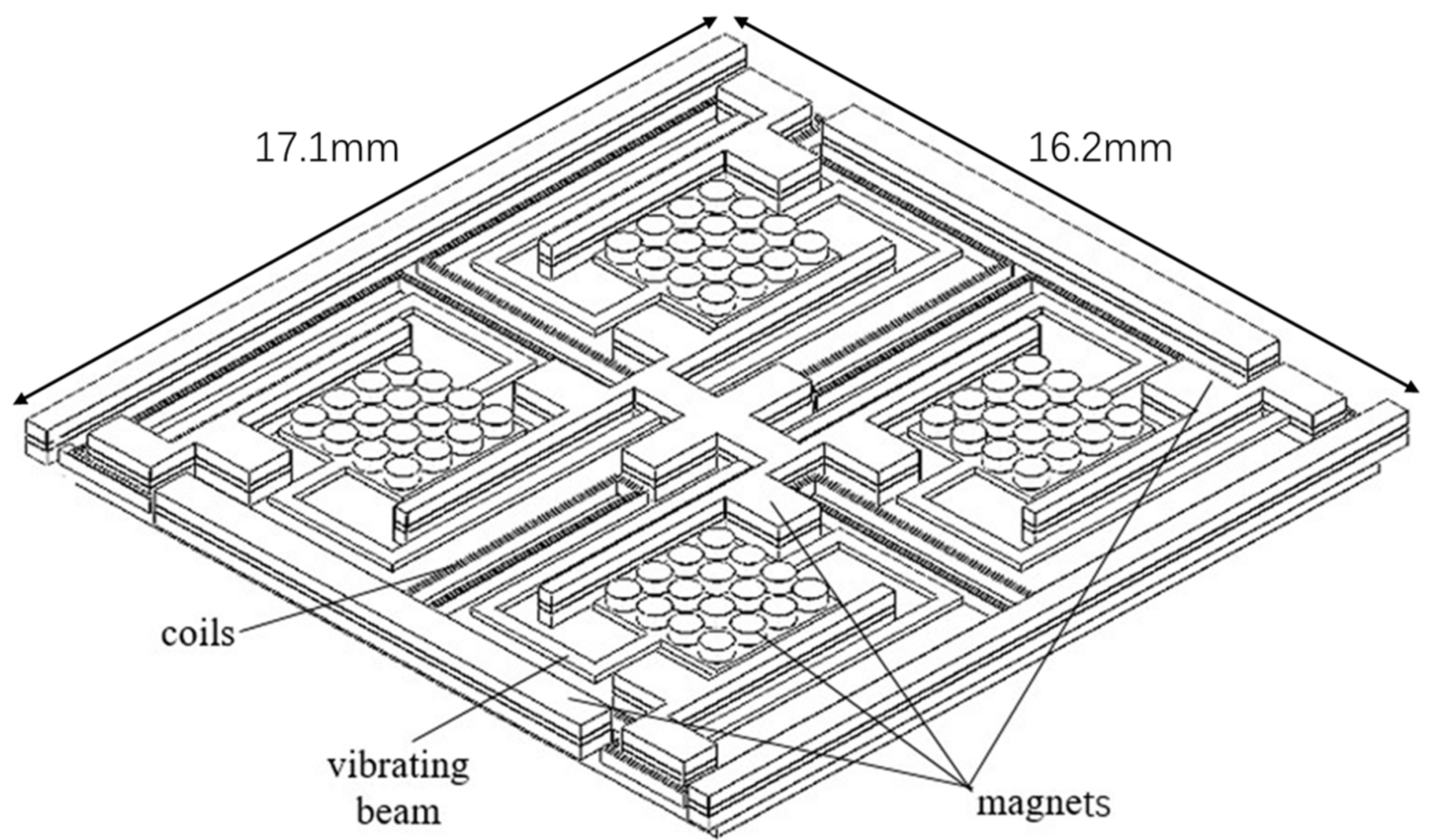
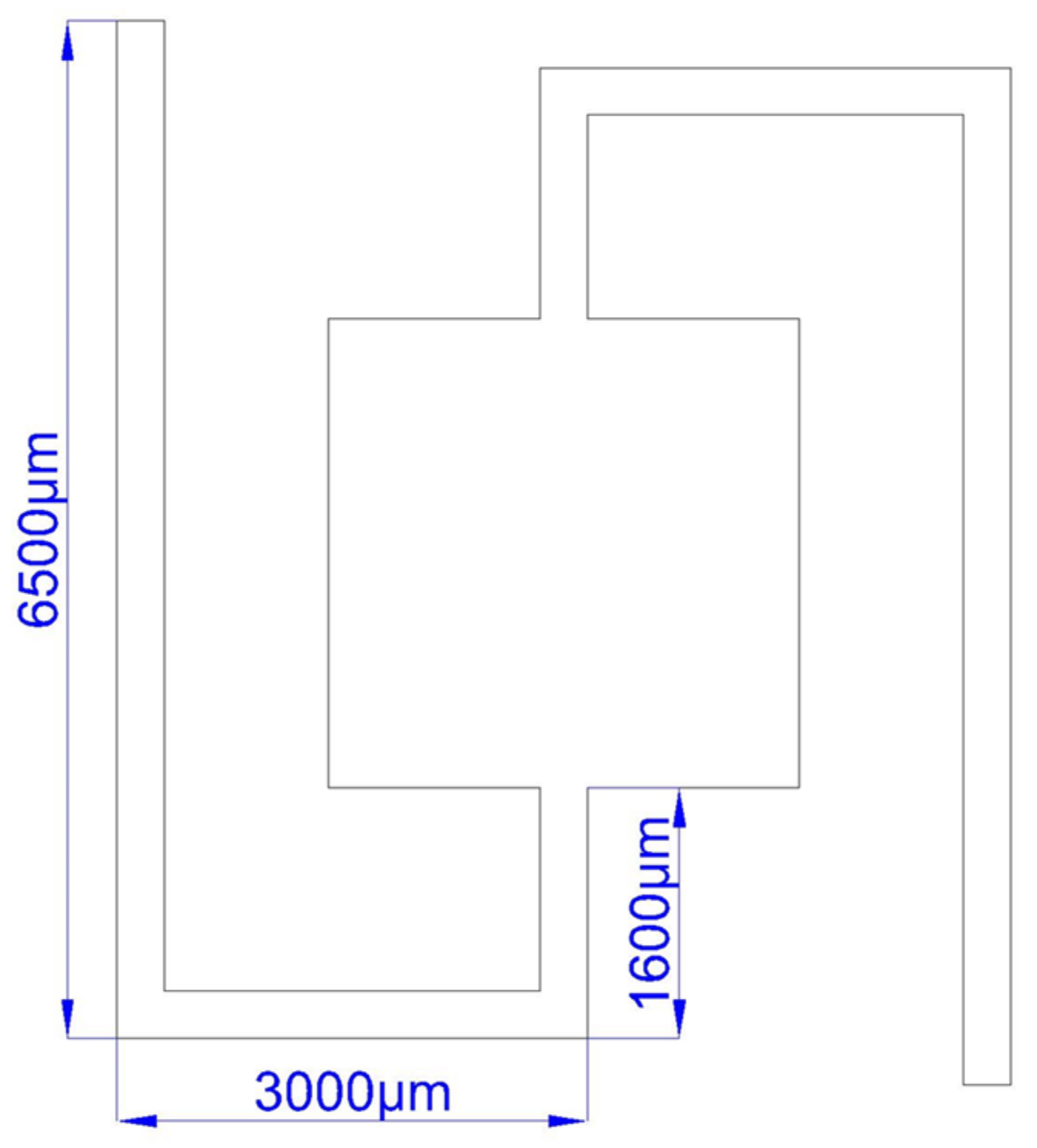
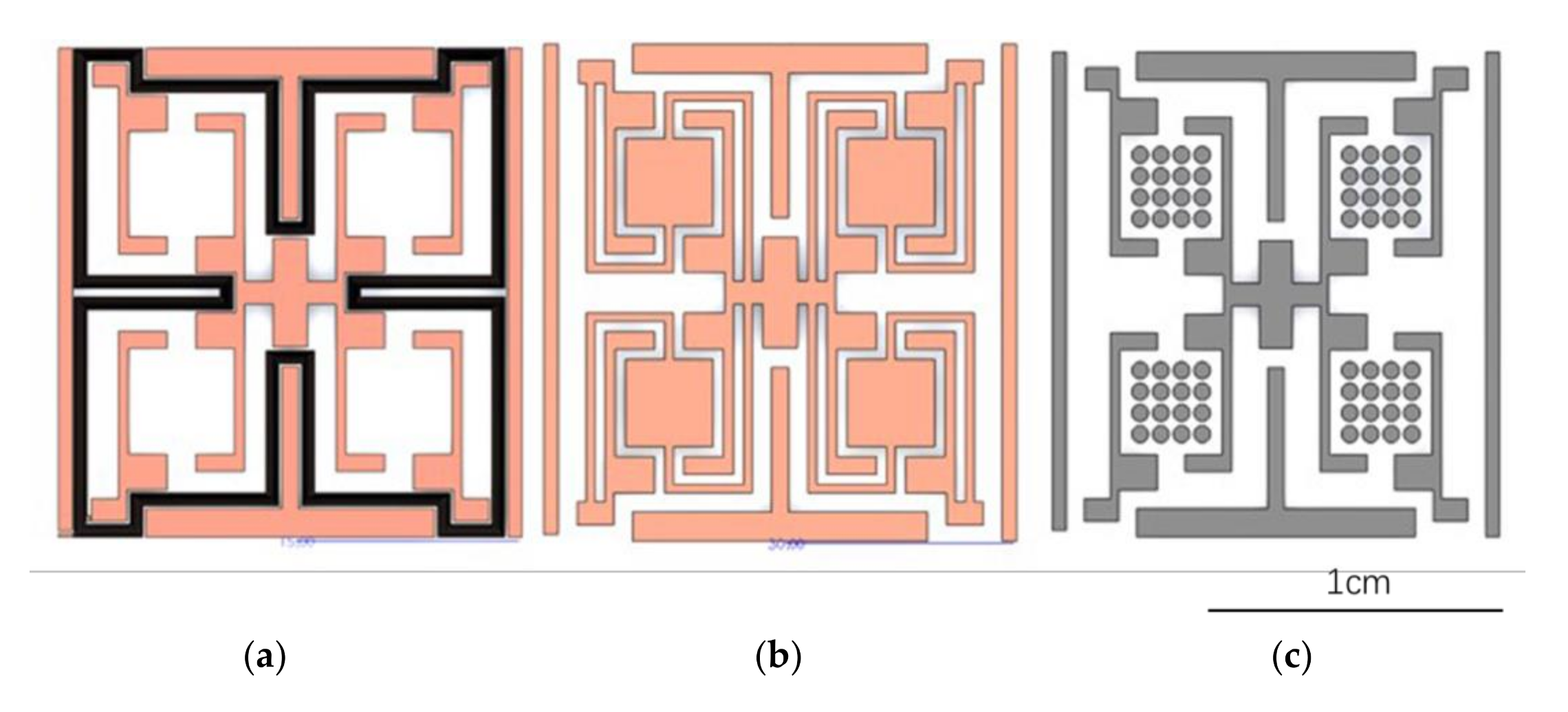


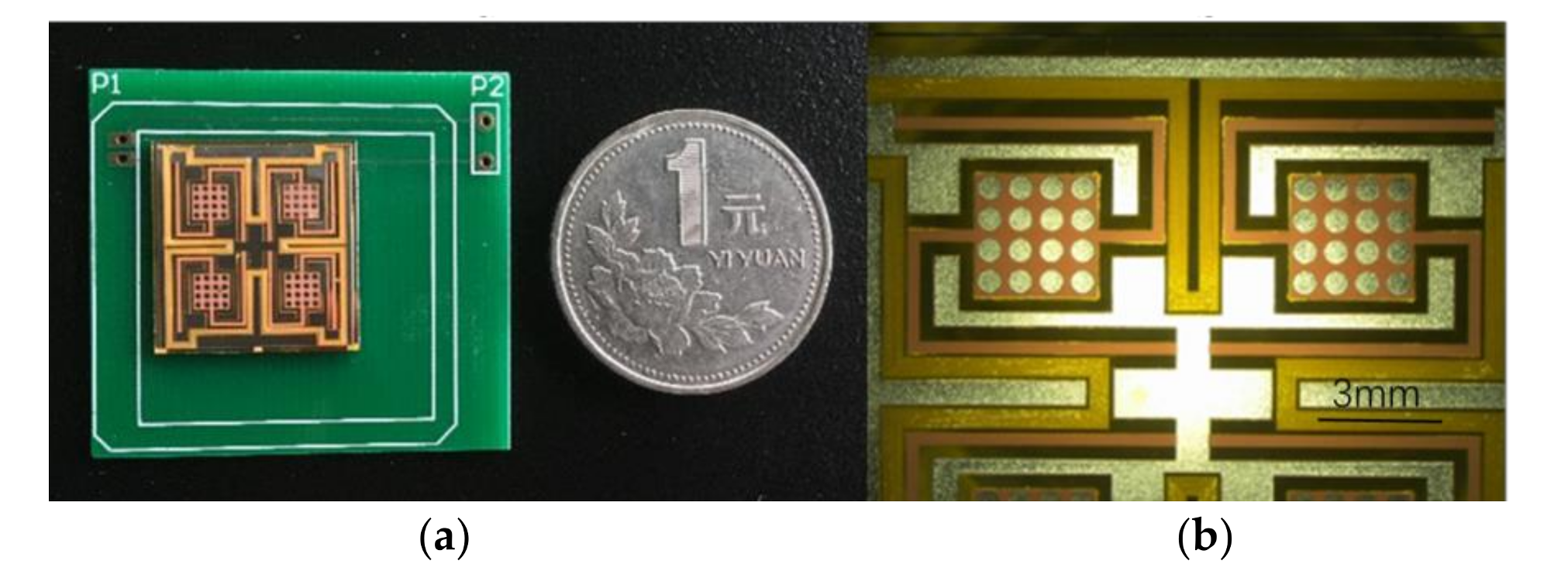
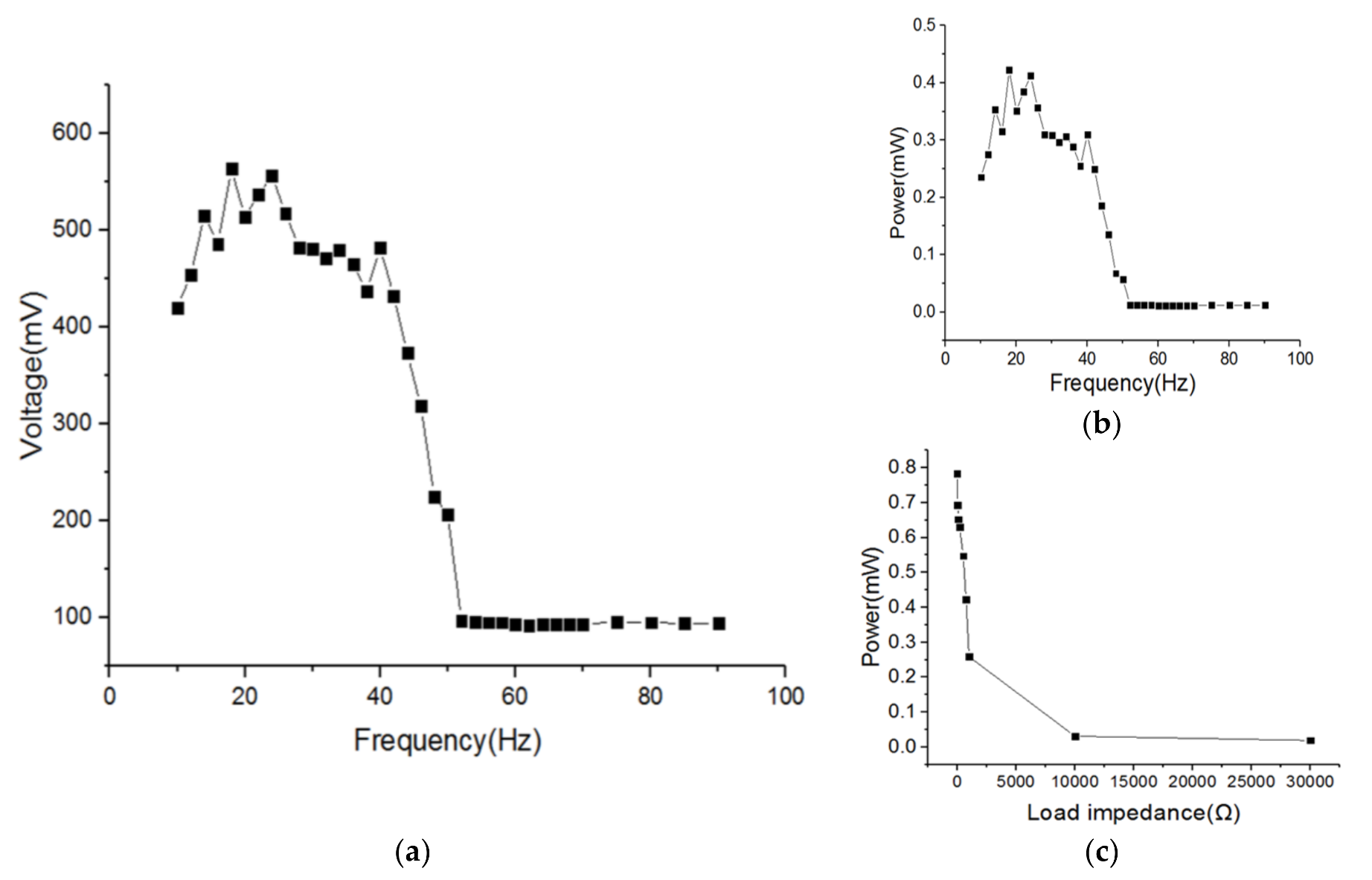
| Energy Storage | Energy Density (Wh/kg) | Power Density (W/kg) | Cycle Life |
|---|---|---|---|
| Super Capacitor | 0.2–20 | 7000–18,000 | >100,000 |
| Lithium Ion Battery | 100–150 | 100–150 | <1000 |
© 2018 by the authors. Licensee MDPI, Basel, Switzerland. This article is an open access article distributed under the terms and conditions of the Creative Commons Attribution (CC BY) license (http://creativecommons.org/licenses/by/4.0/).
Share and Cite
Zhang, W.; Dong, Y.; Tan, Y.; Zhang, M.; Qian, X.; Wang, X. Electric Power Self-Supply Module for WSN Sensor Node Based on MEMS Vibration Energy Harvester. Micromachines 2018, 9, 161. https://doi.org/10.3390/mi9040161
Zhang W, Dong Y, Tan Y, Zhang M, Qian X, Wang X. Electric Power Self-Supply Module for WSN Sensor Node Based on MEMS Vibration Energy Harvester. Micromachines. 2018; 9(4):161. https://doi.org/10.3390/mi9040161
Chicago/Turabian StyleZhang, Wenyang, Ying Dong, Yushan Tan, Min Zhang, Xiang Qian, and Xiaohao Wang. 2018. "Electric Power Self-Supply Module for WSN Sensor Node Based on MEMS Vibration Energy Harvester" Micromachines 9, no. 4: 161. https://doi.org/10.3390/mi9040161





